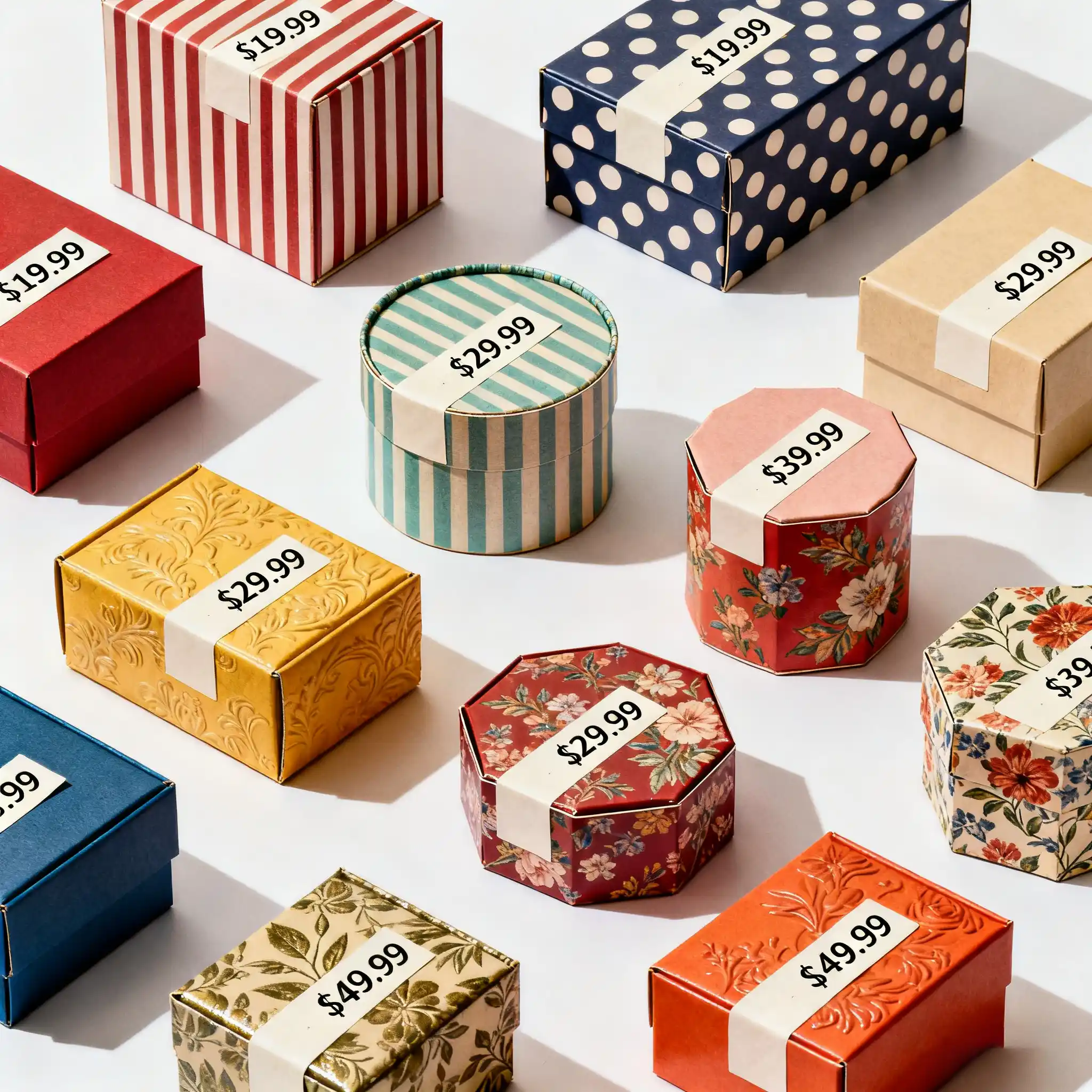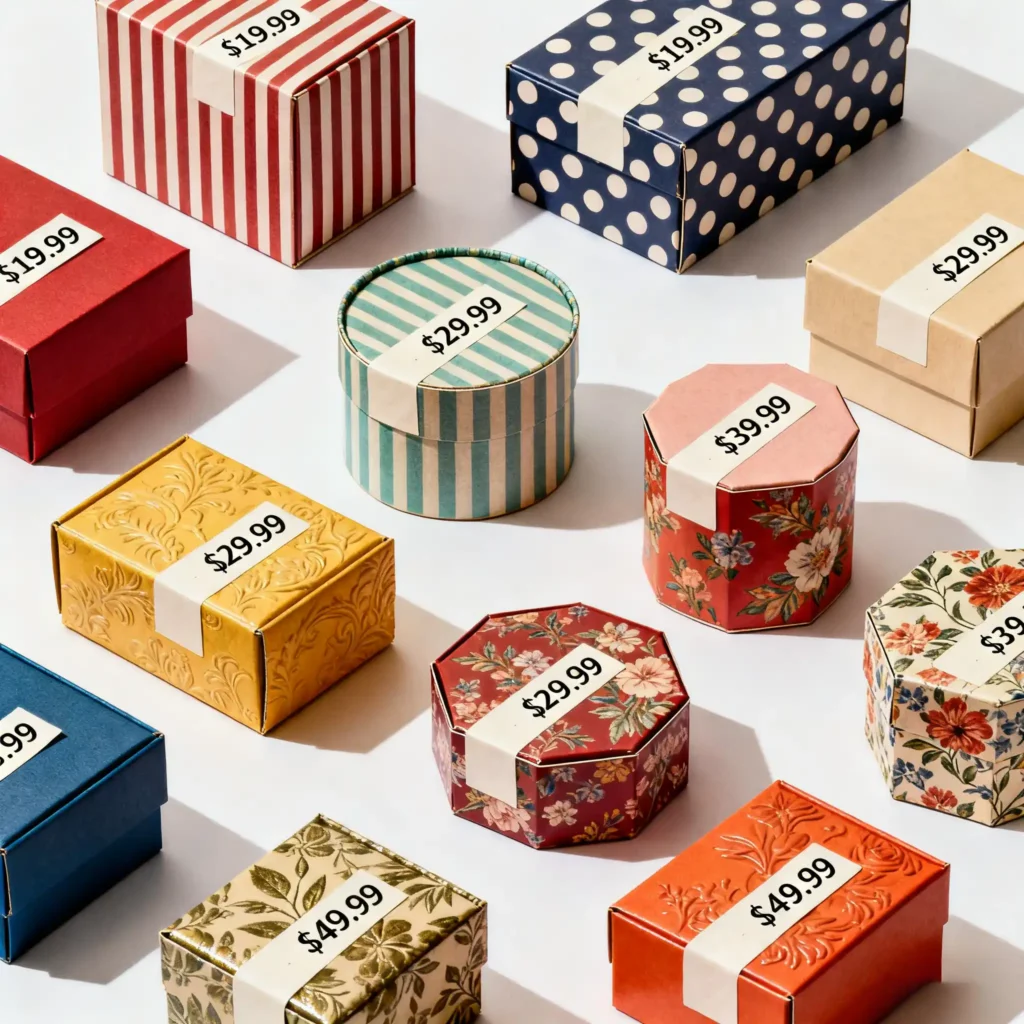Struggling to budget for your next project? You have a great design, but the final cost of bringing it to life feels like a complete mystery, leaving you stuck.
The final cost of custom packaging depends on five key factors: materials, size, order quantity, printing complexity, and finishes. For a standard mailer box, you can expect to pay anywhere from $1 to over $10 per unit, with significant price breaks for larger orders.

I know how it feels. You've poured your heart into a design, and now you have to navigate the tricky world of production costs. It’s a path I’ve walked many times over my 16 years in this industry. It’s easy to get lost in the numbers and technical terms. But don't worry. I'm here to give you a clear roadmap. We'll break down every part of the cost so you can feel confident in your decisions and present a solid budget to your clients. Let's get started.
What Key Factors Influence Your Final Packaging Cost?
You're trying to balance an amazing design with a tight budget. It’s frustrating when you don't know which levers to pull to manage costs without sacrificing quality or your creative vision.
Your final price is shaped by five main things: the packaging's structure and size, your choice of materials, the complexity of your printing and design, any special finishes you add, and the total number of boxes you order. Understanding these helps you make smart choices.

When a designer like you, Peter, comes to me, the first thing we do is talk about these core factors. It’s not about limiting creativity; it's about channeling it effectively. I once worked on a project for a boutique electronics brand. The initial design was beautiful but required a very large, thick box with multi-color printing on all sides. The per-unit cost was way over their budget. Instead of scrapping the design, we looked at the key factors. We slightly reduced the box dimensions to be more efficient on a production sheet, which immediately cut material waste. We changed the printing from offset on all surfaces to a simpler, elegant one-color design on the outside with a vibrant, digitally printed interior. This "reveal" experience was even better for the customer. Finally, we showed them the price difference between ordering 1,000 units versus 5,000 units. By ordering a slightly larger quantity, the per-unit price dropped by 40%. The client was thrilled. They got a stunning box, stayed within budget, and had inventory for their next batch. This is what I mean by pulling the right levers. Let's look at these in a more structured way.
| Factor | Low Cost Impact | High Cost Impact | My Advice for Designers |
|---|---|---|---|
| Structure & Size | Standard shape (e.g., mailer, RSC), smaller dimensions. | Custom die-cut shape, oversized dimensions. | Stick to standard styles unless a custom shape is essential for the product. Always measure the inside dimensions carefully to ensure a snug fit without wasted space. |
| Material | Folding carton (SBS), standard corrugated. | Rigid board, specialty papers, thick corrugated. | Match the material to the product's weight and value. Don't use a heavy-duty material for a lightweight item. |
| Printing | 1-2 color flexographic, simple digital printing. | Full-color offset, printing on all surfaces. | Use complex, full-color printing where it has the most impact, like the front panel or interior. A simple exterior can build anticipation. |
| Finishes | None, simple varnish. | Foil stamping, embossing, spot UV, lamination. | A single, well-placed finish like an embossed logo can feel more premium than multiple finishes used without a clear focus. |
| Quantity | 5,000+ units. | Under 500 units. | If possible, persuade your client to order a higher quantity. The setup costs are the same for 500 or 5,000 boxes, so a larger run drastically lowers the per-unit price. |
How Do Different Materials and Finishes Change the Price?
You've found the perfect paper texture, but you're worried it will blow the budget. It's tough when the materials and finishes that elevate your design are also the most expensive ones.
Material choice is your biggest cost driver. A simple folding carton is the most budget-friendly, while premium rigid boxes are the most expensive. Finishes like foil stamping or embossing add cost but also perceived value. Balancing these is key to meeting your budget.

Choosing the right material is a conversation I have every single day. It's where your design skills and my production experience meet. A few years ago, a designer wanted to create a package for a luxury skincare line. He was set on a heavyweight rigid box, but the brand was a startup and couldn't afford it. I understood his vision for a premium feel. Instead of saying no, I suggested an alternative: a high-quality folding carton made from thick, soft-touch paperboard. We used a simple, elegant debossed logo on the front and a matte lamination. This combination gave the box a beautiful, tactile feel and a premium look, but at nearly half the cost of a rigid box. The client loved it, and it was a huge success. You see, it's not always about picking the most expensive option. It's about understanding how materials and finishes work together to create the desired experience. The competitor article gives a good overview of how much custom packaging costs, but let's break it down with a designer's focus.
| Material Type | Price Range (per unit) | Best For | Designer's Note |
|---|---|---|---|
| Folding Carton | $0.50 - $4.00 | Lightweight retail products like cosmetics, food, or software. | Very versatile for printing and finishes. A great canvas for creative graphics. Kraft paper gives an eco-friendly vibe, while SBS paperboard offers a clean, bright surface for colors. |
| Corrugated | $1.00 - $8.00 | E-commerce shipping, subscription boxes, heavier retail products. | Strength is its key feature. You can print directly on it for a rustic look (flexographic) or wrap it with a printed sheet for a premium feel (litho-lamination). Think about the unboxing experience—print on the inside! |
| Rigid Box | $4.00 - $15.00+ | Luxury goods, electronics, high-end gifts. | This is the top tier. The cost comes from the heavy chipboard and the hand-assembly required. To manage costs, use a standard size and focus on one spectacular finish, like a magnetic closure or a foil-stamped logo. |
Are There Hidden Costs in Design, Printing, and Shipping I Should Know About?
You've approved a quote, but then extra charges appear. Setup fees, shipping costs, and design revisions can inflate your budget unexpectedly, causing major headaches for you and your client.
Yes, there are often "hidden" costs. These can include one-time tooling fees for custom shapes, plate setup charges for offset printing, and surprisingly high freight shipping costs. Always ask for a fully itemized quote that includes these potential extras.

This is an area where experience really matters. I always tell designers to think beyond the per-unit price. Early in my career, I learned this the hard way. We produced 2,000 beautiful boxes for a client, and the per-unit cost was great. But I forgot to account for the freight shipping of the fully assembled boxes. The volume was huge, and the shipping cost was almost as much as the production run! It was a painful lesson. Now, I always plan for logistics from the very beginning. For example, if you're making rigid boxes, using a collapsible style can save you a fortune on shipping and warehousing. For printing, remember that offset printing has high setup costs (for the plates) but a low per-unit cost on large runs. Digital printing has no setup cost but a higher per-unit cost, making it perfect for smaller quantities or prototypes. Always get a prototype made. It might cost a little extra upfront, but it can save you from a disastrously expensive mistake on a full production run.
| Cost Area | Potential "Hidden" Fee | How to Manage It |
|---|---|---|
| Design & Prototyping | Die Plate / Tooling Fee: A one-time charge for creating the custom cutter for your box shape. Can be $300 - $1000+. | This is a necessary investment for custom shapes. Confirm if it's a one-time charge. For future runs of the same box, you won't pay it again. |
| Printing | Plate Charges: For offset and flexo printing, each color requires its own plate. Can be $200 - $500 per color. | To reduce this, simplify your color palette. A smart 2-color design can often be more impactful than a busy 4-color one. Digital printing avoids this fee entirely. |
| Shipping & Logistics | Freight Costs: The cost to ship the finished boxes from the factory to you. Based on volume (dimensional weight), not just weight. | Get a shipping estimate early! Consider where your factory is located. Also, ask for your boxes to be shipped flat whenever possible to dramatically reduce the volume. |
Conclusion
Understanding the factors that drive packaging costs—materials, quantity, and design—empowers you. It turns a confusing process into a series of clear, manageable decisions for your next great project.






